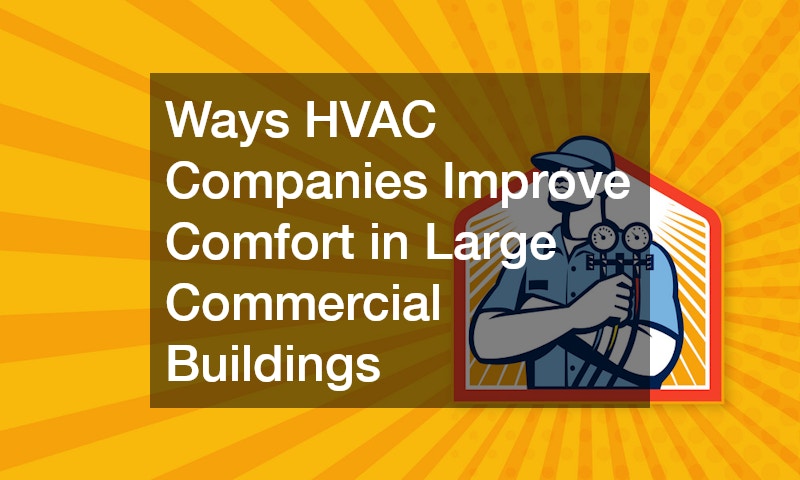
In this article, we will explore the various methods and strategies that HVAC companies employ to enhance comfort in large commercial buildings, ensuring a conducive environment for workers and occupants alike.
Air quality is paramount in large commercial buildings, where hundreds or even thousands of occupants share the same space. HVAC systems are designed with advanced filtration technologies that trap pollutants, allergens, and particulate matter, ensuring that the air remains clean and healthy.
Video Source
These systems utilize HEPA filters and UV-C lights that further eliminate bacteria and viruses, providing a safe breathing environment.
In addition to filtration, HVAC companies employ ventilation strategies that significantly improve indoor air quality. By incorporating methods such as energy recovery ventilators, they ensure a continuous exchange of indoor and outdoor air. This balance helps control humidity levels and reduces the likelihood of mold growth, which can be a significant concern in commercial settings.
Moreover, HVAC systems can be equipped with sensors that monitor air quality in real-time. These sensors can detect rising levels of CO2 and other pollutants, triggering increased ventilation to maintain proper air quality. Keeping air quality at optimal levels not only fosters a healthy work environment but also enhances overall productivity and satisfaction among employees.
Temperature control is a crucial aspect of comfort in large commercial buildings. Uneven temperatures can lead to discomfort among occupants, affecting their ability to focus and perform tasks efficiently. HVAC systems address this by utilizing sophisticated thermostats and sensors that provide precise control over temperature settings across different zones of a building.
These systems can adaptively respond to changes in occupancy and external weather conditions, ensuring a stable indoor climate. For instance, advanced HVAC setups often include programmable thermostats that allow for customized settings during work hours, promoting energy efficiency while maintaining optimal comfort.
Additionally, the distribution of heating and cooling throughout the building is engineered to prevent hot or cold spots. This uniformity in temperature not only enhances comfort but also encourages a more productive work environment. By ensuring that every corner of a large space remains conducive for work or social interaction, HVAC companies play a vital role in occupant satisfaction.
Zoning systems are essential in addressing the varying needs of different spaces within large commercial buildings. These systems allow for individualized control of heating and cooling in separate areas, catering to the unique requirements of various departments while conserving energy. For instance, conference rooms, which may see fluctuating occupancy levels, can be set to different temperatures compared to the largely occupied office spaces.
By segmenting the building into zones, HVAC systems can avoid the pitfalls of a one-size-fits-all approach. Each zone can be managed through independent thermostats, allowing for flexibility and personalization of comfort settings. This zoning not only maximizes inhabitants' comfort but also contributes to energy savings, as less conditioned air is wasted in unoccupied areas.
Furthermore, zoning systems can integrate with building management systems, allowing for seamless adjustments based on real-time data. These systems track usage patterns and can anticipate occupancy, enabling the HVAC to adjust accordingly. Such innovation ensures that comfort is consistently maintained across diverse areas within the building.
Regular maintenance is critical for ensuring that HVAC systems operate at peak performance for large commercial buildings. Routine inspections and scheduled servicing allow HVAC companies to identify potential issues before they escalate into significant problems. Key maintenance practices include filters replacement, duct cleaning, and system checks to optimize airflow and efficiency.
The importance of preventative maintenance cannot be overstated. By implementing a maintenance schedule, HVAC companies help extend the lifespan of equipment, improve energy efficiency, and maintain consistent comfort levels throughout the building. Building managers who invest in regular HVAC upkeep frequently report lower operational costs and fewer emergency repairs.
Moreover, employee training on how to operate control systems can complement maintenance practices. Equipping staff with knowledge about optimal settings and behaviors contributes to the overall efficiency of HVAC systems. Together, these practices promote a comfortable indoor environment and ensure that HVAC capabilities are fully realized.
By incorporating advanced technologies, regular maintenance, and effective strategies, HVAC companies play a crucial role in enhancing the comfort of large commercial buildings, ultimately benefiting everyone who occupies the space.
